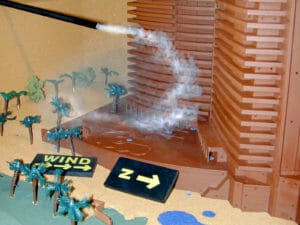News
Outdoor comfort criteria

Our engineers are frequently asked to investigate how proposed structures or proposed changes to structures will affect those who use outdoor spaces. Or we’re tasked with identifying what causes existing areas to be especially windy, and then we offer solutions that address those problems.
But who determines what is comfortable? One person might find a slight breeze pleasant and refreshing, while another individual may find the same conditions intolerable.
Our wind experts gauge measured wind speeds against a series of comfort criteria categories. Referred to as the Lawson criteria after the researcher who developed them, they quantify the worst wind conditions that most users are likely to find tolerable.
The Lawson comfort criteria are divided into two groups, both of which are based on the larger of the mean and what is called the gust equivalent mean (GEM). The GEM is obtained by dividing the peak (3-second) gust wind speed by 1.85. This allows the mean and the GEM to be compared and their relative importance to pedestrian comfort to be assessed.
The first group of criteria, comfort, classifies wind speeds according to activities that one might reasonable conduct under those conditions. Someone sitting at an outdoor cafe and reading a newspaper will become uncomfortable at much lower wind speeds than someone walking briskly to catch the next bus.
Comfort classifications assume that wind speeds exceed the mean or GEM wind speeds less than 5% of the time.
Table 1: Comfort
Slower than 4 m/s (9 mph) | Pedestrian Sitting (considered to be of long duration) |
4–6 m/s (9–13 mph) | Pedestrian Standing (or sitting for a short time or exposure) |
6–8 m/s (13–18 mph) | Pedestrian Walking |
8–10 m/s (18–22 mph) | Business Walking (objective walking from A to B or for cycling) |
Faster than 10 m/s (22 mph) | Uncomfortable |
The second group, distress, captures wind criteria that most people would find so uncomfortable that they couldn’t reasonably conduct normal outdoor activities until the wind event has passed.
Distress classifications assume that wind speeds exceed the mean or GEM wind speeds less than 0.022% of the time.
Table 2: Distress
Up to 15 m/s (34 mph) | Not to be exceeded more than two times per year (or one time per season) for general access area |
Up to 20 m/s (45 mph) | Not to be exceeded more than two times per year (or one time per season) where only able bodied people would be expected; frail or cyclists would not be expected |
These criteria are helpful, but they’re not perfect. So we evaluate each case according to the specific needs and circumstances of our clients.
To learn more about how our outdoor comfort engineers can help you design spaces that are comfortable and safe, please contact CPP today at (+1) 970-221-3371.
